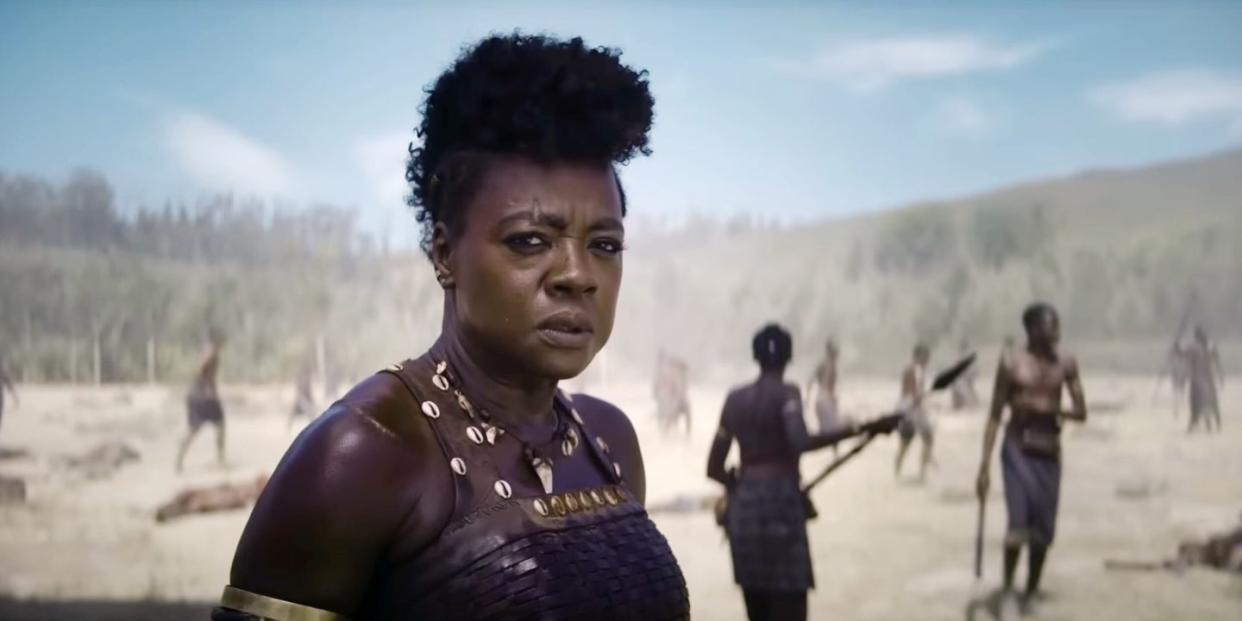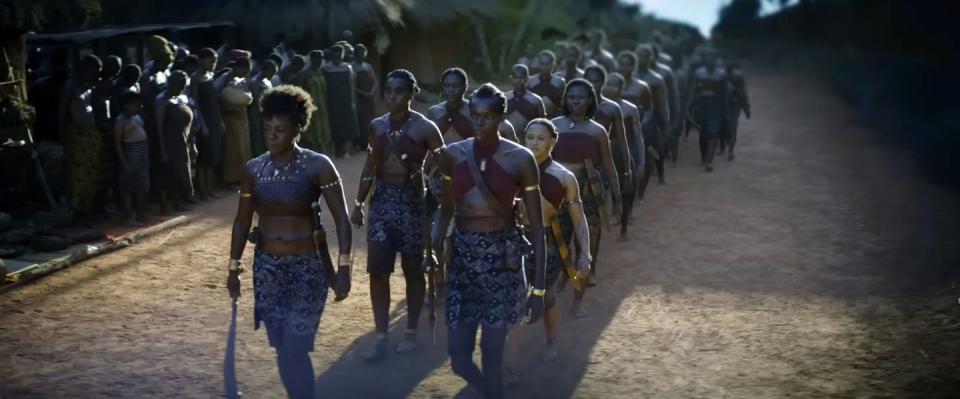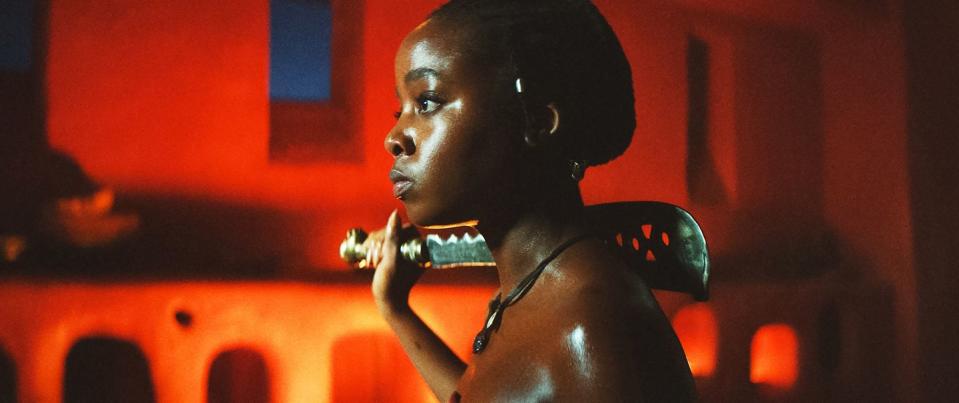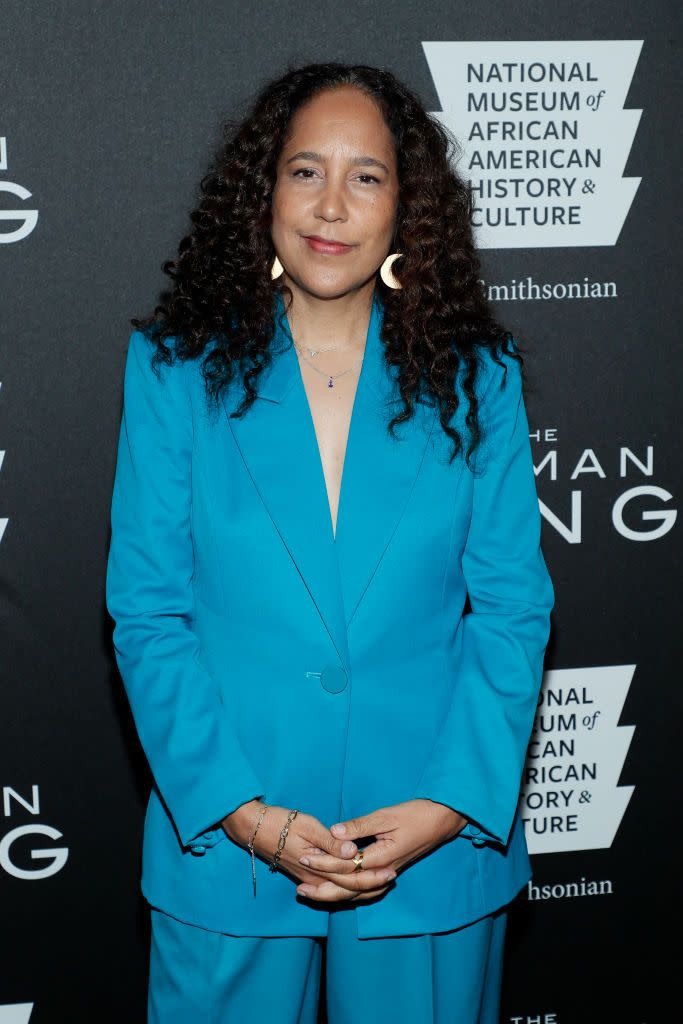Gina Prince-Bythewood and Thuso Mbedu on What Makes 'The Woman King' Soar

- Oops!Something went wrong.Please try again later.
- Oops!Something went wrong.Please try again later.
- Oops!Something went wrong.Please try again later.
The cast and crew of The Woman King will never forget the day when a group of 300 South African background actors broke out into song to stop a torrential downpour on the set of their historical epic film, which had already encountered numerous delays due to the Covid-19 pandemic.
“It started to rain, and I remember I put my head down,” director Gina Prince-Bythewood recalls over Zoom. “I was like, ‘Oh my God, my day is just screwed.’ And as my head was down, suddenly I heard joyful singing, and I looked up and all our background actors were singing and dancing with each other. And at that point, I said to myself, ‘I have to give into this. How often are you going to be able to be within this type of energy?’ … It was a beautiful moment. I know we never would have gotten that [filming] in Atlanta or L.A.; we had to be on the continent.”
That energy is palpable in the final product. Directed by Prince-Bythewood and written by Dana Stevens, The Woman King tells the story of Nanisca (Viola Davis), the skillful, single-minded general of an all-female unit of warriors known as the Agojie, who protected the real-life African Kingdom of Dahomey during the 17th to 19th centuries. As she trains the next generation of recruits for battle against the heavily armed Oyo Empire, an enemy determined to destroy her people’s way of life, Nanisca crosses paths with Nawi (Thuso Mbedu), an outspoken orphan who seeks to join the Agojie after refusing to be married off for money.
In a joint interview with BAZAAR.com, Prince-Bythewood and Mbedu speak about the film’s revolutionary depiction of sisterhood and womanhood, the character traits that can be revealed in the intricate action sequences, and the importance of having Black women at the center of big-budget Hollywood movies.
Gina, what are some things that you learned from directing The Old Guard that came in handy on The Woman King, and what were some things you learned on this project that you’re looking to put in your toolbox for future films?
Gina Prince-Bythewood: The most important thing I took from Old Guard is my fight coordinator Danny Hernandez, who is an incredible genius not only in his design of action, but also the way that he trains and motivates the actors. I knew we were going to have a group of women who had never done this before, except for Lashana [Lynch], [so] how do we get them to the level where they can do their own action? It was a tall order, but Danny loved the script and wanted the challenge of being able to create these female warriors. To do what these actors did took so much training, so much mental toughness—to train six days a week, two times a day, for months is extraordinary. But he motivated them, kept them excited, pulled them up when they were down. And then on set, when you’re going 15, 16, 17 takes, he’s got that same energy on every single take.
And when you’re going onto 18 or 19 takes and the actors are tired, you’re tired and you’re seeing your day slip away, there’s such a temptation to say, “We got it good enough.” You cannot leave that scene, that moment, until you have it, or you’re screwed in the editing room, so one of the big things I learned is what it takes to really do really good action and capture it and make sure that you have it to cut together. I learned on this film that vulnerability can be a strength, because I just didn’t grow up that way. As an athlete and a female director in this industry, you do not show vulnerability, but with these actors showing vulnerability and me being really willing to go there [with them] actually connected me and allowed them to trust me more than if I just never showed anything. And that was a real surprise and something that I will remember going forward—just being able to articulate that type of vulnerability to actors who are literally giving me everything.
Gina, what were some of the cultural nuances that you were really adamant about depicting onscreen, and why do you think that attention to cultural detail is so incredibly important?
GPB: When you do an historical epic, I know an audience is going to look up onscreen and take what they see as truth. I knew that we were creating a fictional story, but within this world, I was going to tell the truth—and that was not only in the details, but also in what was happening historically at the time. The big fight with the Oyo that Dahomey goes through, and the slave trade—that was all based on fact. It was really important to separate the oppressors’ version of history and those who get to tell their own history. So we had incredible consultants who are from there, whose ancestors are from there. The more I dove into it, the more things I found that were exciting and that I wanted to put into the script, so I think it makes the writing and the storytelling better.
The thing that was most important to me was to tell the true sisterhood of these women, knowing and reading about how they lived and died for each other. The amount of time they spent training to be able to defend the kingdom and beat these male armies that were coming at them. The use of music and dance was something that I learned in the research—how they would create these elaborate, choreographed dances to celebrate each other and the king. And also the dynamics in a kingdom where these women had autonomy; they had a stay in the kingdom. [With] the council being half men, half women, that was based on what Ghezo [the real former king of Dahomey] wanted to do that no other kingdom had done, so those things that you just don’t think about in the 1800s were really happening in this kingdom.

Thuso, what did you find the most striking and fascinating about the history of the Agojie warriors?
TM: Their strength and their resilience. [This is] a group of women whose voices and whose existence mattered. I’m from the Zulu tribe, we still have a monarchy back in South Africa, we have the king of the Zulus, and it’s very patriarchal. Women are [supposed to be] submissive, do as they’re told—those dynamics are still alive and active today, and there was never another option in terms of existence. In the story, we see that there was another option, and their existence resulted in actual changes in history.

There’s a pivotal scene in the communal bath between Nanisca and Nawi that marks a turning point in the movie. Thuso, what can you tell me about the experience of shooting that scene, and how would you describe the evolution of Nanisca and Nawi’s relationship, which is more complicated than it seems?
TM: Nanisca, at first, is this idol for Nawi. [Nawi] wants to be an Agojie, and she says she wants to be admired and feared and wanted. What I realized for her is that she fears being alone more than dying, which is why she’s willing to go into the army. She gets there and almost immediately feels rejected by Nanisca. They clash, because Nawi has a very combative, rebellious spirit. She’s of a younger generation, she’s able to fight and speak up for herself, and that’s not necessarily how it works. [Nawi] goes from admiring Nanisca to being a person that’s like, “You will see what I’m capable of, and you will respect me.” But then she has this very beautiful relationship with Izogie, which I think is what she would have wanted from Nanisca. So that moment in the bath for me, it’s a scene that Gina, Viola and I were very careful about, because of what it means in the story.
Gina shared very private information for me to truly understand what that moment meant for her, so for me it was about serving the characters as truthfully as possible, but also serving Gina and her personal journey through the character. The scene itself is so complex, because Nawi receives news that, if played irresponsibly, could have cost us that moment that we had worked so hard to earn. For Nawi, the revelation hits her in bursts. It’s an emotional moment for both of them, [but] they are people who have been taught not to show weakness, and it was Nanisca who told Nawi, “You have to kill your tears.” It’s been drilled into her not to care, not to feel, and not to show pain, so what does that look like in that moment [for them]?
Gina, I also wanted to ask about the first fight scene of the film, when the Agojie are rising from the tall grass slick with palm oil, machetes in hand and fingernails filed to be weapons. What did you want to convey about the power of these warriors, and how did it feel for you as a director to have that as the first scene to introduce these women?
GPB: I want to reframe the fact that female athletes can be athletic, can have an athletic frame, and that’s still feminine. It does not take away from your femininity. But also [I wanted to] change the narrative of, if you’re a woman, you can’t be courageous, you can be a fighter. That’s just not true, but that is pounded into your head as a girl constantly. And then as a woman, [you’re told] to be quiet, to be smaller, and that rise about the grasses obliterates that. These are not made up superheroes; these are real women that we are embodying.
We shot that on day one, and to shoot a big action scene as your first thing is brilliant and is terrifying, because you know the actors are training, training, training, and you’re working on choreography all the way up until shooting. And then you start to shoot, and it’s hard to maintain that, so [I was like], “Let’s go in, and everyone will be at their peak when we’re shooting that.” I wanted to start the process of them feeling that power too. We took it eight times and [what’s] in the movie is take seven, and I remember I was like, “It’s close, close, close.” And then on take seven, I felt it in my gut.

It’s been a couple of weeks since the film made its world premiere at TIFF and then premiered in theaters. What are some of the fan reactions that have really stuck out to you?
GPB: There was a group of, like, 20 women in a theater bathroom. They had just seen the movie, and they’re all doing the warrior cry-out, and the camera is spinning around. They’re all laughing and calling out, and then it ends with a woman just saying, “Women King.” That’s the energy that you want. But also a woman saw it, and she said that we may not feel the impact of this film for a couple of years until you start to see how many little girls are named Nawi or Nanisca, and I totally see that [happening] because it’s allowing people to see themselves in the way they’ve never seen before.
TM: Viola, [who was on a press tour] in Brazil, sent me a video of these girls that they want to see, and they were singing for her. And then she has a picture of four of them in the Agojie uniform, and I thought that was the sweetest thing, because that’s who we’re doing it for.
Thuso, this film was shot in your native South Africa. When you look back on the experience of making this film, what are some of the stories that you will be telling for years to come?
TM: I think the story of making the film itself is a story that I’ll be telling for years. The fact that I spent the first two weeks shooting in my home province is something that I will carry with me until the end of time—just being able to communicate in my mother tongue with everybody around. There was a genuine comradery that came with that. People were genuinely excited to see us create the story, and we had tons of fun as cast and crew outside of work.
[I remember] waking up in the morning and being able to see elephants and giraffes, and all these different animals, knowing that we’re going to create something amazing. And what’s funny is that South Africans actually take offense [to that comment] about how we woke up in the morning and we’re driving to work and we’re seeing elephants and giraffes and wildlife. They’re like, “Americans are going to think this is what happens in Africa.” But that’s the reality. At night, they said, “Don’t work alone, because there might be lions and cheetahs around.” Every part of it was absolutely unforgettable—[even] the wretched sun and the treacherous winds in Cape Town!
Gina, is there a reason why you’re against sequels? And would you make an exception if there was a reason to return to this world in some capacity?
GPB: [Laughs.] When I take on a project, I tell the story I want to tell. And if I haven’t said everything I wanted to say, then something went wrong. I should feel satiated when I look up on the screen, and I’ve been blessed—knock on wood—that every movie that I’ve done, I’ve been able to look up and say, “That was my vision. That is a story I wanted to tell.” I’ll go watch a sequel, [but] I won’t let sequels be done from my personal work, as much as it’s flattering that people want to have sequels to some of my earlier work. There are thousands of different stories that we can tell from the continent, and let’s use this as a springboard to finding other new amazing stories to tell.
There’s a line in the film that really stuck with me: “Even if they are not Dahomey, they are our people.” The people involved in this movie have assumed the responsibility of taking ownership of stories that would otherwise go untold and giving opportunities to actresses who have historically been overlooked. What message do you hope this film will send about the value and importance of having Black women, especially dark-skinned Black women, at the forefront of big-budget movies?
TM: As a child, you’re seeing so many different faces and people onscreen, and you believe them, so in you, there is something that says, “I can be anything.” [But] you get to the industry and they say, “No, you cannot. You’re confined to this. You can only do this much because of how you look.” [But] this film is saying, “No, these people here, we are more than capable of telling any story. We just need the opportunity.” Seeing people of all races crying, rooting for us was awe-inspiring because we’ve been rooting for everyone from the jump.
GPB: For me as a Black female filmmaker, I want us in every single genre, and we haven’t had that opportunity. I’ve never gotten to go to a theater and see myself in a Braveheart, in a Gladiator. So to be able to make this film, and have all different audiences in a theater together cheering at the same time, crying at the same time, clapping at the same time, that’s what you want. It shouldn’t matter what the people onscreen look like, even though the cultural specificity is what makes it so interesting. You get to go into the world you don’t know, but it should never keep you from being able to connect and root for and identify with who’s up there. I want to prove that you can go to the theater the same way that you could go to see Avatar and connect with these blue people, you can [also] connect with us.
This interview has been edited and condensed for length and clarity.
The Woman King is now playing in theaters.
You Might Also Like

